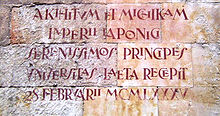Víctor (symbol)
The Víctor or Vítor is a symbol that is used as an honorary decoration in Spanish-speaking countries.
Meaning and design
Víctor or Vítor comes from the Latin word victor , "winner". The word is also used as an interjection of applause , especially in the context of the ceremony for the award of a doctorate.
The symbol consists of the letters V-Í-TOR and V-Í-CTOR, which are artfully connected to one another in the manner of a monogram , similar to a Christ monogram . The Víctor is usually attached to the outer walls of (university) buildings by students after completing their doctorate with red-brown color. In the past, bull's blood or pigment paint was used for this purpose. In addition, the name of the graduate, the year of the doctorate and sometimes an explanatory text are usually added. Care is taken to ensure that the type of monogram design differs from the other vítores already attached.
history

The tradition of writing one's name on the wall of the university building after receiving his doctorate has existed for centuries.
With the Ley Moyano (1857), the award of doctoral degrees was limited to the University of Madrid for decades . For example, the University of Salamanca was only allowed to award doctorates again from 1954. In the meantime, this had an impact on the placement of the Víctor symbols in the university towns.
The Víctor was used as a symbol of victory by the Spanish dictator Franco during his rule. The symbol was already used on his victory parade ( El gran desfile de la victoria ) on May 19, 1939.
In many places, new Víctor signs are no longer being attached and the old symbols are disappearing due to the weather and environmental pollution.
The Víctor in Salamanca
The city of Salamanca is particularly known for the vítores , where the symbols can be found on many buildings.
For the University of Salamanca there is the opinion that the letter C was added later. This should represent the crescent moon , which an allusion to Papa Luna , the Pope Benedict XIII. (1342 / 43–1423) who had driven the expansion of the university.
The Víctor is also dedicated to prominent people from the university. This happened, for example, with heads of state and government such as the former Spanish Prime Minister Adolfo Suárez , the then Japanese Crown Prince Akihito and his wife Michiko , the politicians Fernando Henrique Cardoso , Ricardo Lagos , Aristides Royo , former rectors such as Miguel de Unamuno , Enrique Tierno Galván , Francisco Tomás y Valiente and the UNICEF children's aid organization .
The long-standing Spanish dictator Franco , who had his headquarters in the city during the civil war in 1936/1937 , also has a monogram dedicated to the cathedral of Salamanca .
At the University of Salamanca, every student after completing their doctorate can still put a vítor on the walls of their faculty today.
Further spread
In addition, the signs were or are widespread in Seville (for example in Calle Alemanes and Avenida de la Constitución ) as well as at the Archivo General de Indias and outside of Spain at the Universidad Nacional Mayor de San Marcos (Lima, Peru). and spread in Ciudad Rodrigo .
Individual evidence
- ↑ a b Real Academia Española : Diccionario de la lengua española de la Real Academia Española , entry vítor , online version (Spanish).
- ↑ a b c Silvia Nuñez Moro: Actos patronales. The festival of Santo Tomas de Aquino. Online , pp. 70–72 (pdf, Spanish; 249 kB).
- ↑ El Misacantano y el Doctorado. January 19, 2011, Retrieved December 18, 2011 (Spanish).
- ↑ Curiosidades de la Universidad de Salamanca. Retrieved December 18, 2011 (Spanish).
- ↑ Cf. Escritos con sangre de toro: Los "vítores" de Salamanca. (pdf; 456 kB) (No longer available online.) Archived from the original on November 9, 2013 ; Retrieved December 18, 2011 (Spanish). Info: The archive link was inserted automatically and has not yet been checked. Please check the original and archive link according to the instructions and then remove this notice.
- ↑ Luis Enrique Rodríguez-San Pedro Bezares: Bosquejo histórico de la Universidad de Salamanca, Universidad de Salamanca, 2002, p. 49 ( limited preview on Google Books ).
- ↑ See El gran desfile de la victoria. June 20, 2009, Retrieved December 19, 2011 (Spanish).
- ↑ a b c Santiago Belausteguigoitia: El misterio de los vítores. October 11, 2009, Retrieved December 18, 2011 (Spanish).
- ↑ José María Iribarren, José María Romera: El porqué de los dichos: Sentido, origen y anécdota de los dichos, modismos y frases proverbiales de España con otras muchas curiosidades. Institución Príncipe de Viana, 2005, p. 125 ( limited preview on Google Books ).
- ↑ Homenaje Institucional al Excmo. Sr. D. Adolfo Suárez González. April 29, 2011, Retrieved December 18, 2011 (Spanish).
- ↑ a b See Vitores. Retrieved December 18, 2011 (Spanish).
- ↑ A UNICEF. (No longer available online.) February 22, 2010, archived from the original on October 9, 2011 ; Retrieved December 18, 2011 (Spanish). Info: The archive link was inserted automatically and has not yet been checked. Please check the original and archive link according to the instructions and then remove this notice.
- ^ Angel Gutierrez, David Zurdo: La vida secreta de Franco. EDAF, 2005, p. 122 ( preview on Google Books ).
- ↑ ¿Cuáles son las gestiones para pintar un vítor en un centro universitario? Retrieved December 18, 2011 (Spanish).
- ↑ Juan Carlos Talavera Velezmoro: Vítores y “hieroglificos”: celebraciones triunfales en la ciudad de Lima. February 2, 2010, Retrieved December 18, 2011 (Spanish). [1]



